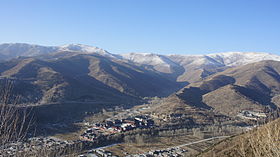Mount Wutai, with its five flat-topped peaks, is a sacred mountain for Buddhism. Its cultural attractions include 41 temples, including the East Hall of Foguang Temple, the tallest surviving Tang Dynasty wooden structure, which contains life-size clay sculptures. It also features the Ming Dynasty Shuxiang Temple, which contains 500 statues that weave Buddhist stories into a three-dimensional picture of mountains and rivers. Overall, the architecture on Mount Wutai records the development of Buddhist architecture over more than a thousand years and its influence on Chinese palace architecture. Mount Wutai, which literally means "Five Terraces", is the highest mountain in northern China and is striking for its rugged terrain and five empty, treeless peaks. Temples were built here from the 1st century AD to the early 20th century.
| IPA transcription |
4703312 |
| office held by head of the organization |
http://g.co/kg/m/02_z2c |
| Commons category |
Mount Wutai |
| coordinate location |
Point(113.566944444 39.081388888) |
| official website |
http://www.wutaishan.cn |
| topic's main category |
Blagoevgrad Province |
| page banner |
http://commons.wikimedia.org/wiki/Special:FilePath/WV%20banner%20Wutaishan%20Natp.jpg |
| described by source |
Gujin Tushu Jicheng |
| native label |
五台山 |
| elevation above sea level |
3061 |
| area |
18415 |
| World Heritage criteria |
World Heritage selection criterion (vi) |
| World Heritage criteria |
World Heritage selection criterion (ii) |
| World Heritage criteria |
Larousse Encyclopedia online |
| image |
http://commons.wikimedia.org/wiki/Special:FilePath/Taihui.jpg |
| instance of |
mountain |
| located in the administrative territorial entity |
Category:Way of Saint James UNESCO World Heritage Sites in France |
| executive body |
Mount Wutai |








